The art: light, color, space, etc.
Light and color
As mentioned in the previous section, many Schafer paintings exhibit dramatic use of large areas of intense, saturated color and contrasting light. For example, a brilliant sky and sunlit riverbank may vividly contrast with a dark forest between. A dark pool of water may be adjacent to a bright sandy beach. Schafer had an excellent eye for color; his choice of color for deserts, desert mountains, mountains obscured by haze, and the sky of a western sunset is sometimes startlingly effective. Similarly dramatic are the lighting and coloring effects in campfire scenes under moonlit cloudy skies. Schafer's palette generally is dominated by many harmonizing shades of green and brown, augmented with baby blue and varying shades of silver-grey in the sky--the sky palette is often reminiscent of Corot1--and accented with small spots of contrasting bright color in the rendering of a wildflower, a campfire, or an item of clothing on a distant figure.
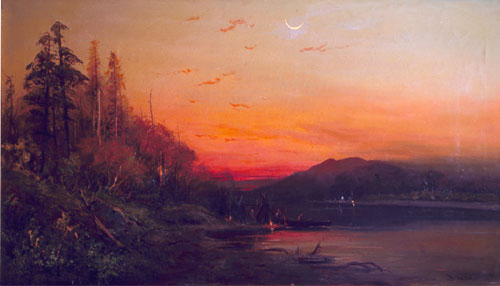 |
| Evening on Goose Lake |
Some of Schafer's sunset scenes, such as Evening on Goose Lake, at the right, depict a brilliant coral or golden yellow sky. For the eighteen months following November 1883, brilliant and unusually colored sunsets were common in Northern California as a result of the explosive eruption in August of Krakatau, an Indonesian volcano.2 This fact might help in establishing dates for some of the sunset paintings.
Space, scale, and perspective
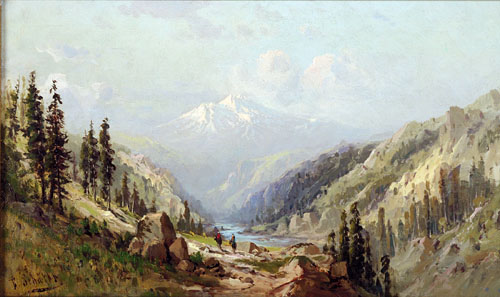 |
| On the Upper Sacramento River |
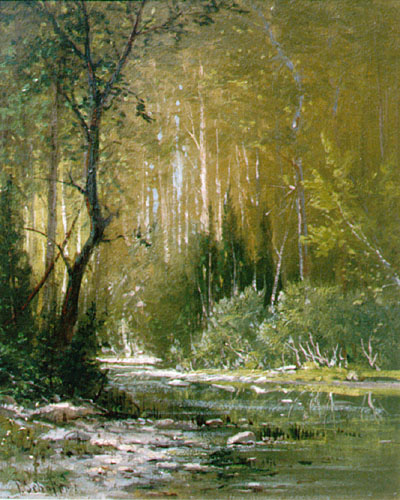 |
| [California coastal stream] |
Usually, these scenes are developed as a series of planes parallel to the painting surface, with relatively uncomplicated interconnections. There are also quite a number of forest interiors, such as [California coastal stream]4, at the right, in which the canvas is completely covered with forest, there is no horizon, and at most a few small spots of sky peek through the branches, a space treatment frequently used by the Barbizon painters.
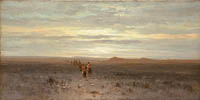 |
| [Going to the pow-wow. Indian scene, Montana] |
In contrast, the desert scenes such as [Going to the pow-wow. Indian scene, Montana] (shown at the left), as well as [Indian camp in Winter 1], and [Two Indians in a desert landscape], not only have infinite horizons, but they also omit any framing elements, providing an uninterrupted view of the sky. This alternate treatment of space contrasts strongly with the mountain landscapes; it emphasizes the vast expanse of the prairie and the limitless sky above.
Figures of people or animals appear in many Schafer landscapes, almost always depicted in the middle distance, as in [Going to the pow-wow. Indian scene, Montana], (above left). By their small size these figures provide the eye with a measure of, and emphasize, the large scale of the scene. As discussed in the section on iconography they do not seem to be intended as genre elements, but rather are part of the landscape itself.
Unlike some other nineteenth-century western artists, landscape perspective is usually very accurate in Schafer paintings; all parts of a scene are viewed from a single vantage point. At the same time, this basically correct perspective is sometimes diluted by using planes that are too few and too distinct, and oversimplifying the connections among them.
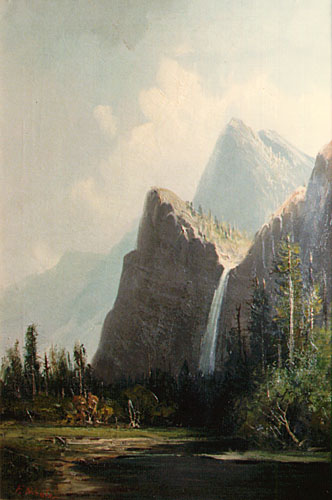 |
| [Bridal Veil Fall, Yosemite Valley 5] |
Depiction of water
Many Schafer paintings have a river, stream, waterfall, inlet, lake, or bay somewhere in them. Schafer's treatment of the shape and position of water is notably natural; inlets and backwaters never float in the air, rivers always follow the geography smoothly downhill, and the rendition of waterfalls is convincing. A second characteristic of Schafer's style in handling water is that it almost never provides a mirror-like reflection. Even when a quiet pool is depicted, it is at least slightly roiled, so that reflections are indistinct shapes with color as the primary indication of what is being reflected. [Bridal Veil Fall, Yosemite Valley 5], at the right, illustrates these characteristics.
1. In a personal communication, Alfred Harrison, Jr. pointed out Schafer's Corot-like sky palette.
2. The impact of the unusual sunsets on the art of the day is described in Simkin, T. and R. S. Fiske, Krakatau, 1883, pages 395-407. Symons, G. J., editor, The Eruption of Krakatoa, and Subsequent Phenomena, a contemporary report to the Royal Society, also mentions the sunset effects on pages 151, 167, and 298. A modest version of the same effect was visible throughout much of the world during the winter of 1991-1992, following the eruption of Mount Pinatubo in the Philippines.
3. A discussion of space-enclosing style may be found in Baigell, Matthew, Albert Bierstadt.
4. Throughout this catalog, square brackets surround title words not assigned by the artist.